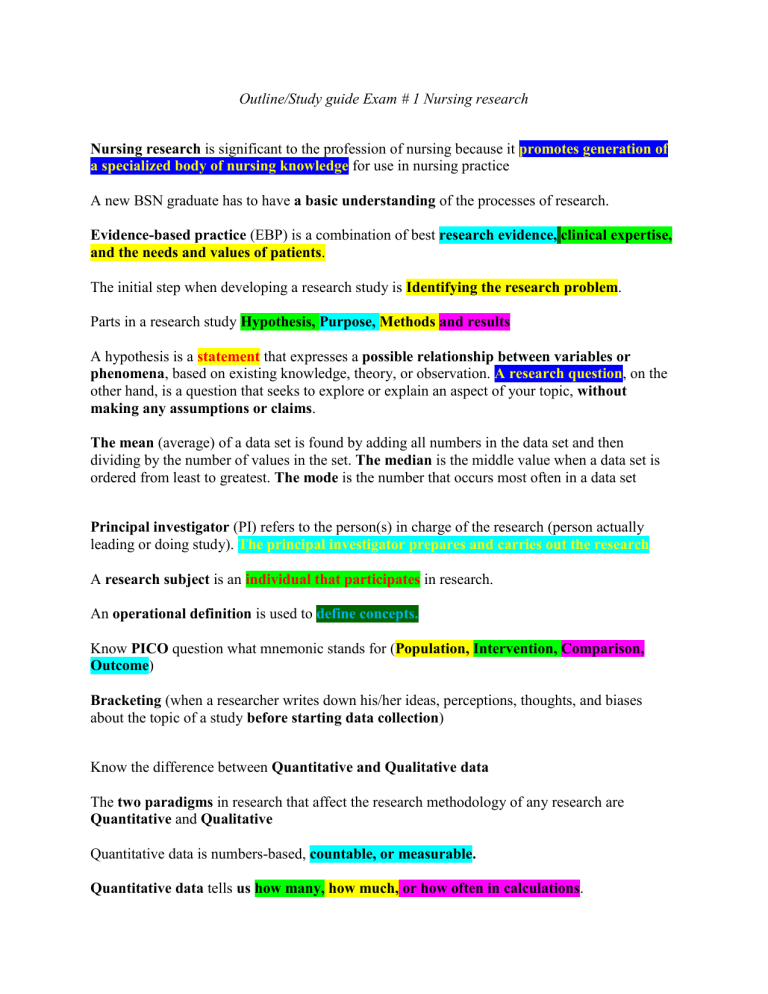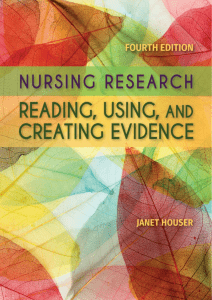
Outline/Study guide Exam # 1 Nursing research Nursing research is significant to the profession of nursing because it promotes generation of a specialized body of nursing knowledge for use in nursing practice A new BSN graduate has to have a basic understanding of the processes of research. Evidence-based practice (EBP) is a combination of best research evidence, clinical expertise, and the needs and values of patients. The initial step when developing a research study is Identifying the research problem. Parts in a research study Hypothesis, Purpose, Methods and results A hypothesis is a statement that expresses a possible relationship between variables or phenomena, based on existing knowledge, theory, or observation. A research question, on the other hand, is a question that seeks to explore or explain an aspect of your topic, without making any assumptions or claims. The mean (average) of a data set is found by adding all numbers in the data set and then dividing by the number of values in the set. The median is the middle value when a data set is ordered from least to greatest. The mode is the number that occurs most often in a data set Principal investigator (PI) refers to the person(s) in charge of the research (person actually leading or doing study). The principal investigator prepares and carries out the research. A research subject is an individual that participates in research. An operational definition is used to define concepts. Know PICO question what mnemonic stands for (Population, Intervention, Comparison, Outcome) Bracketing (when a researcher writes down his/her ideas, perceptions, thoughts, and biases about the topic of a study before starting data collection) Know the difference between Quantitative and Qualitative data The two paradigms in research that affect the research methodology of any research are Quantitative and Qualitative Quantitative data is numbers-based, countable, or measurable. Quantitative data tells us how many, how much, or how often in calculations. Qualitative data is interpretation-based, descriptive, and relating to language. Research designs collect data through interviews, observations, and interactions Qualitative data can help us to understand why, how, or what happened behind certain behaviors. . Ethics in research The Tuskegee Syphilis Study (unethical study in previous history involved withholding a treatment from subjects to study the effects of a disease progression on subjects) When obtaining informed consent from study subjects, the researcher will ensure that subjects freely choose whether or not to participate and will provide subjects with General knowledge and overview of the study Cognitive impairments subjects need a legally authorized guardian must give informed consent The purpose of an institutional review board (IRB) in a university or clinical agency is to protect the human rights of subjects in proposed studies The ethical principles of respect for persons, beneficence (doing good to others), and justice are considered essential elements in research involving human subjects and are identified in the National Commission for the Protection of Human Subjects in the Belmont Report. Justice (subject’s right to fair selection and treatment in a study) Beneficence (ethical principle protects human subjects from harm) Respect for persons means that we recognize that each person has the right and capacity to make her or his own decisions. Respecting a person ensures that dignity is valued. In a blind review for a peer-reviewed journal the reviewers of the article did not know the identity of the author For a study to be considered current, it should be published within the last 5 years. Only Groundbreaking or landmark studies will be cited in a literature review may be decades old A summary and critique of another's scholarly work is an example of a secondary source in a literature review Types of research/studies: Correlational study Quantitative research method that examines the relationship of two variables and describes the strength and direction of the relationship between them Experimental study focuses on introducing an intervention to one group and comparing the outcome to that of another group that has not experienced the intervention? Longitudinal study A nurse researcher monitors women with breast cancer for depression before and throughout their chemotherapy treatment. Research participants were involved in this research study for 2 years Descriptive research aims to accurately and systematically describe a population, situation or phenomenon. It can answer what, where, when and how questions, but not why questions. Quasi-experimental research are studies that aim to evaluate interventions but that do not use randomization. Quasi-experiments aim to demonstrate causality between an intervention and an outcome. An example of a quasi-experiment is studying a specific classroom of students to determine certain learning outcomes. Participants are predetermined because they were students in that specific classroom prior to the study Cross-sectional studies are observational studies that analyze data from a population at a single point in time. They are often used to measure the prevalence of health outcomes, understand determinants of health, and describe features of a population. Example Cross-sectional studies measure the cause (exposure) and the effect (disease) at the same point in time. They compare the rates of diseases or symptoms of an exposed group with an unexposed group. Retrospective study investigates outcomes specified at the beginning of a study by looking backwards at data collected from previous patients. (Example) a sample is selected and the researcher looks back at the history of the members of this sample. A researcher might examine the medical histories of 1000 elderly women to identify the causes of health problems. Applied study/research is a type of examination looking to find practical solutions for existing problems. These can include challenges in the workplace, education, and society.





